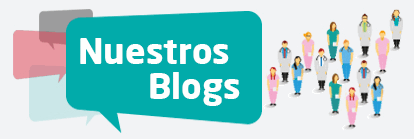History
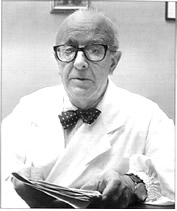 Doctor Carlos Jiménez Díaz has been present in Madrid since 1927, as Professor of Medical Pathology at Atocha School of Medicine. His idea of bringing together research and clinical practice becomes a reality when, with the help of a group of philanthropic financiers, the Medical Research Institute is set up in Pavilion nº 1 of the School of Medicine on the university campus, attached to the Chair of Professor Jiménez Díaz. It is inaugurated on Tuesday, 13th February 1935, hence the reason why the clinic celebrates this date every year. This first group of collaborators includes Doctors Barreda, Ochoa, Castro, Arjona, Miñón, Vivanco, Villasante, Parra, Alés, Paniagua and Morales..
Doctor Carlos Jiménez Díaz has been present in Madrid since 1927, as Professor of Medical Pathology at Atocha School of Medicine. His idea of bringing together research and clinical practice becomes a reality when, with the help of a group of philanthropic financiers, the Medical Research Institute is set up in Pavilion nº 1 of the School of Medicine on the university campus, attached to the Chair of Professor Jiménez Díaz. It is inaugurated on Tuesday, 13th February 1935, hence the reason why the clinic celebrates this date every year. This first group of collaborators includes Doctors Barreda, Ochoa, Castro, Arjona, Miñón, Vivanco, Villasante, Parra, Alés, Paniagua and Morales..
However, Jiménez Díaz’s project coincides with the stormy years of civil war in Spain, causing disruption and delays. The war comes to end, things return to normal, and, at the end of 1939, research resumes at the Clinical and Medical Research Institute, working out of a hotel that a group of doctors, including Don Carlos, rent on Calle Granada in Madrid.
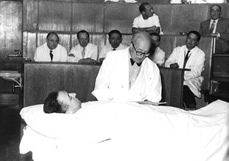 Clinical session After its transfer to School of Medicine Pavilion nº 2 on the university campus. It is now the 1940s, and the enthusiastic efforts of Jiménez Díaz and his team have brought notable results: lathyrism is described; nitrogen mustards are used in treating rheumatoid arthritis; autoimmune disease is defined, etc. Many people have joined the clinic: Lorente, Lara, Albert, Bañón, Grande, Linazasoro, Marina, Pariades, Sentí, Fernández Criado, Leoz, Puente, Boixadós, Orbaneja, Masjuán, Arias... This is not a complete list, and others will also be added over time.
Clinical session After its transfer to School of Medicine Pavilion nº 2 on the university campus. It is now the 1940s, and the enthusiastic efforts of Jiménez Díaz and his team have brought notable results: lathyrism is described; nitrogen mustards are used in treating rheumatoid arthritis; autoimmune disease is defined, etc. Many people have joined the clinic: Lorente, Lara, Albert, Bañón, Grande, Linazasoro, Marina, Pariades, Sentí, Fernández Criado, Leoz, Puente, Boixadós, Orbaneja, Masjuán, Arias... This is not a complete list, and others will also be added over time.
The years go by, and the 1950s mark the beginning of a new decade for Jiménez Díaz, as he persists in his ambition to provide a place where healthcare, teaching and research can all come together.
And he finds support from Blas Pérez, the Minister of the Interior, which was the ministry in charge of the Health Department. Pérez proposes to Francisco Franco, the Head of State, that the former Rubio Institute should be integrated with the Institute of Medical Research, leading to Clínica de la Concepción being set up with a modest financial endowment. The Surgery Sector will henceforth bear the name of Federico Rubio.
The Board of Trustees at Rubio Institute at the time was made up of Professors Bertrán, Carro, Landete, Leoz, Montau, Rodríguez Zúñiga, Valle, López Dóriga and a great-grandson of Federico, Reixa Garcia del Busto.
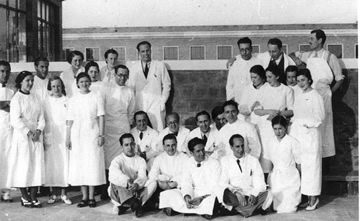
This is what Jiménez Díaz had dreamed of: integrated medicine where both public and private patients would be treated; a place where doctors can work full-time; a place where clinical and medical research laboratories can address issues that arise at the patient’s bedside and investigate their aetiologies, causes, and potential treatments.
After many difficulties, Clínica de la Concepción opens on 1st June 1955 with 120 beds and a group of doctors and healthcare professionals excited about a bright future. An agreement is signed with the then National Social Security Institute to treat public patients from the very beginning.
From 1955 onwards, a group of young doctors who had trained in a range of countries join the initial group of physicians that had affiliated with Jiménez Díaz before and immediately after the civil war. Horacio Oliva, Luis Hernando, Pedro Rábago, Mariano Jiménez Casado, José Antonio Sánchez Martín, Rafael Ortega, Gregorio Rábago, José Sanchez Fayos, Joaquín Serrano, Alfonso Merchante, Fernandez Lahoz, Pedro Fernández del Vallado López... Names may be missing, but they are all young people from La Concepción who bring new techniques with them. The first kidney transplants are performed; open heart surgery with extracorporeal circulation is carried out for the first time in Spain, a blood bank is opened; Nephrology begins, new paths are opened up in Haematology, and therapeutic treatment for processes with electrolyte disorders is established; pathological diagnoses are studied in depth, the first cardiac catheterisations via transauricular puncture take place, the cobalt pump is also installed and isotope diagnostics begin, embodying a sequence of novel diagnostic, research and therapeutic methods at Clínica de la Concepción.
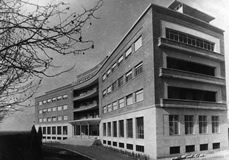 Clínica Concepción With the clinic up and running, Jiménez Díaz pursues his second dream, namely that medical students could study at the Clinic, leading to a small group of students from Universidad Complutense being taught at Fundación Jiménez Díaz for four academic years from 1956 to 1960. However, a series of issues with the faculty at Universidad Complutense around areas of responsibility leads to Carlos deciding, after four years, to bring direct teaching of students at Clínica de la Concepcion to an end. In the 1960s, he focuses on setting up the first educational programmes for Resident Interns. As a result, teaching is available for postgraduates in almost all specialities at Clínica de la Concepción. This same system will be implemented in Spain on a national basis for all teaching hospitals, starting in 1970.
Clínica Concepción With the clinic up and running, Jiménez Díaz pursues his second dream, namely that medical students could study at the Clinic, leading to a small group of students from Universidad Complutense being taught at Fundación Jiménez Díaz for four academic years from 1956 to 1960. However, a series of issues with the faculty at Universidad Complutense around areas of responsibility leads to Carlos deciding, after four years, to bring direct teaching of students at Clínica de la Concepcion to an end. In the 1960s, he focuses on setting up the first educational programmes for Resident Interns. As a result, teaching is available for postgraduates in almost all specialities at Clínica de la Concepción. This same system will be implemented in Spain on a national basis for all teaching hospitals, starting in 1970.
New buildings are progressively added up until 1978 and the Clinical and Medical Research Institute is enlarged, while a new sanatorium is built for private patients.
At the request of the Foundation’s physicians, in 1963 a request is made to unify the Medical Research Institute, Clínica de la Concepción and the Association for the Protection of the Chair of Professor Jiménez Díaz into a single organisation to be known as Fundación Jiménez Díaz, with this being duly established by Decree on 27th June 1963.
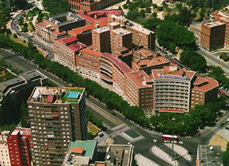 Aerial view Carlos Jiménez Díaz dies in 1967, having successfully consolidated his Foundation. Management of the Foundation is taken on by Eloy López García. Three years after Jiménez Díaz’s passing, and without him having the opportunity to witness it, the Foundation becomes part of the new School of Medicine at Universidad Autónoma de Madrid, transforming into a University Hospital that encompasses both theoretical and practical instruction. Jiménez Díaz’s dream is therefore complete.
Aerial view Carlos Jiménez Díaz dies in 1967, having successfully consolidated his Foundation. Management of the Foundation is taken on by Eloy López García. Three years after Jiménez Díaz’s passing, and without him having the opportunity to witness it, the Foundation becomes part of the new School of Medicine at Universidad Autónoma de Madrid, transforming into a University Hospital that encompasses both theoretical and practical instruction. Jiménez Díaz’s dream is therefore complete.
In 2003, Fundación Jiménez Díaz, a pioneering hospital with more than 75 years of history in Madrid, joins the company.
In 2005, IDC Group joins Capio, a leading Swedish health and care management company operating in 8 countries with over 16,000 employees.
In 2008, Fundación Jiménez Díaz becomes the leading hospital for over 400,000 Madrid residents thanks to its impressive progress in terms of healthcare and economic performance. In 2008, the Pontones and Quintana specialist care centres are assigned to Capio Fundación Jiménez Díaz.
Since then, Fundación Jiménez Díaz has been growing and developing, evolving along with society, standing out in its three particular areas: healthcare, teaching and research.


















